2806NRS Assessment 3: Skin Glue Impact on PIVC Failure Rate
VerifiedAdded on 2022/12/15
|13
|3602
|150
Report
AI Summary
This report provides a critical evaluation of a research article investigating the effectiveness of skin glue in reducing peripheral intravenous catheter (PIVC) failure rates. The study employs a randomized controlled trial design, comparing a standard care group with a skin glue intervention group. The evaluation assesses various aspects of the research, including the title, abstract, literature review, research design, sampling methods, data collection process, data analysis, and results. The report also discusses the relevance of the study's findings to nursing practice, highlighting the potential benefits of incorporating skin glue into standard PIVC insertion protocols to improve patient outcomes and reduce healthcare costs. The article's strengths, such as its rigorous methodology and ethical considerations, are noted, as well as areas for potential future research.
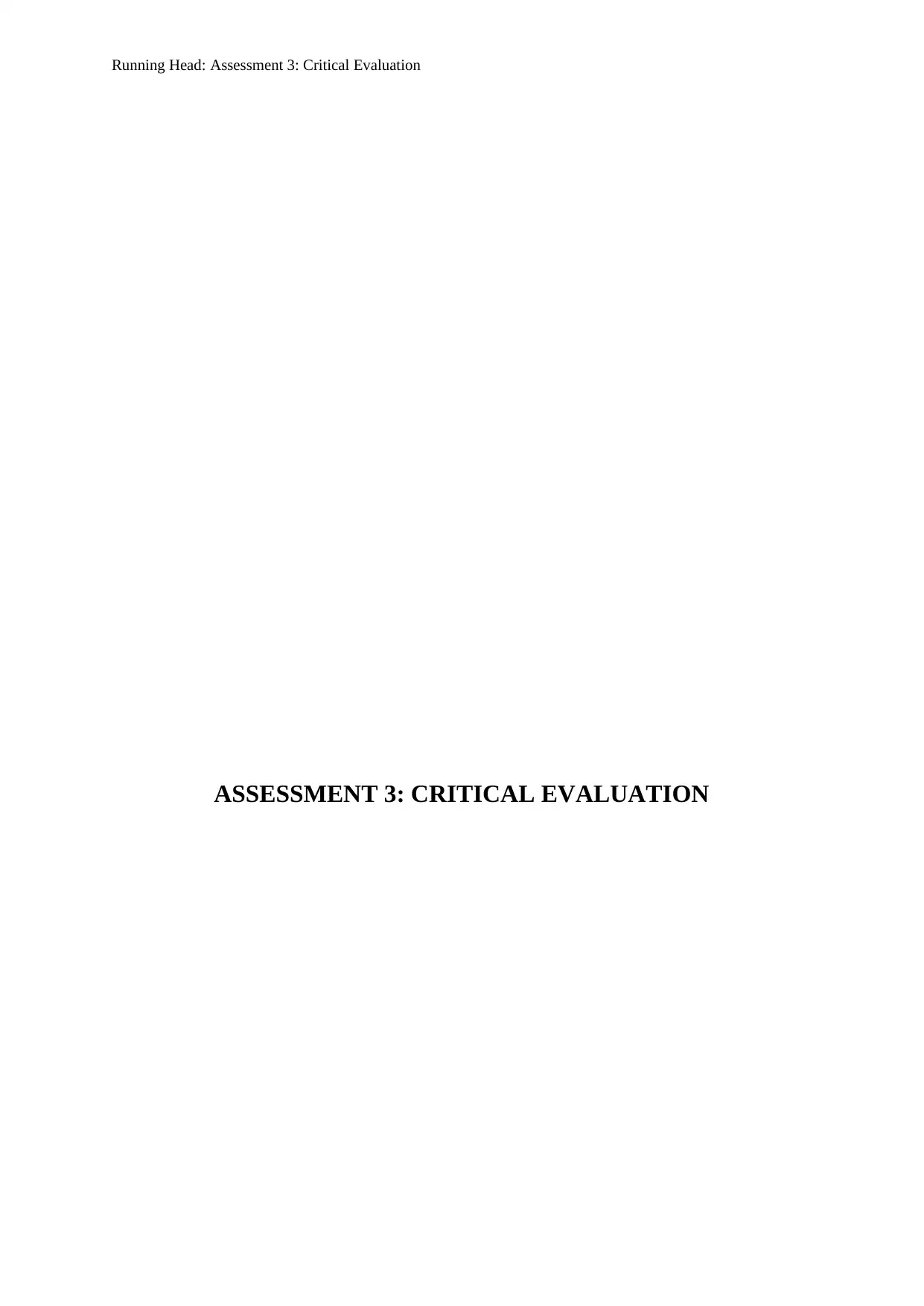
Running Head: Assessment 3: Critical Evaluation
ASSESSMENT 3: CRITICAL EVALUATION
ASSESSMENT 3: CRITICAL EVALUATION
Paraphrase This Document
Need a fresh take? Get an instant paraphrase of this document with our AI Paraphraser
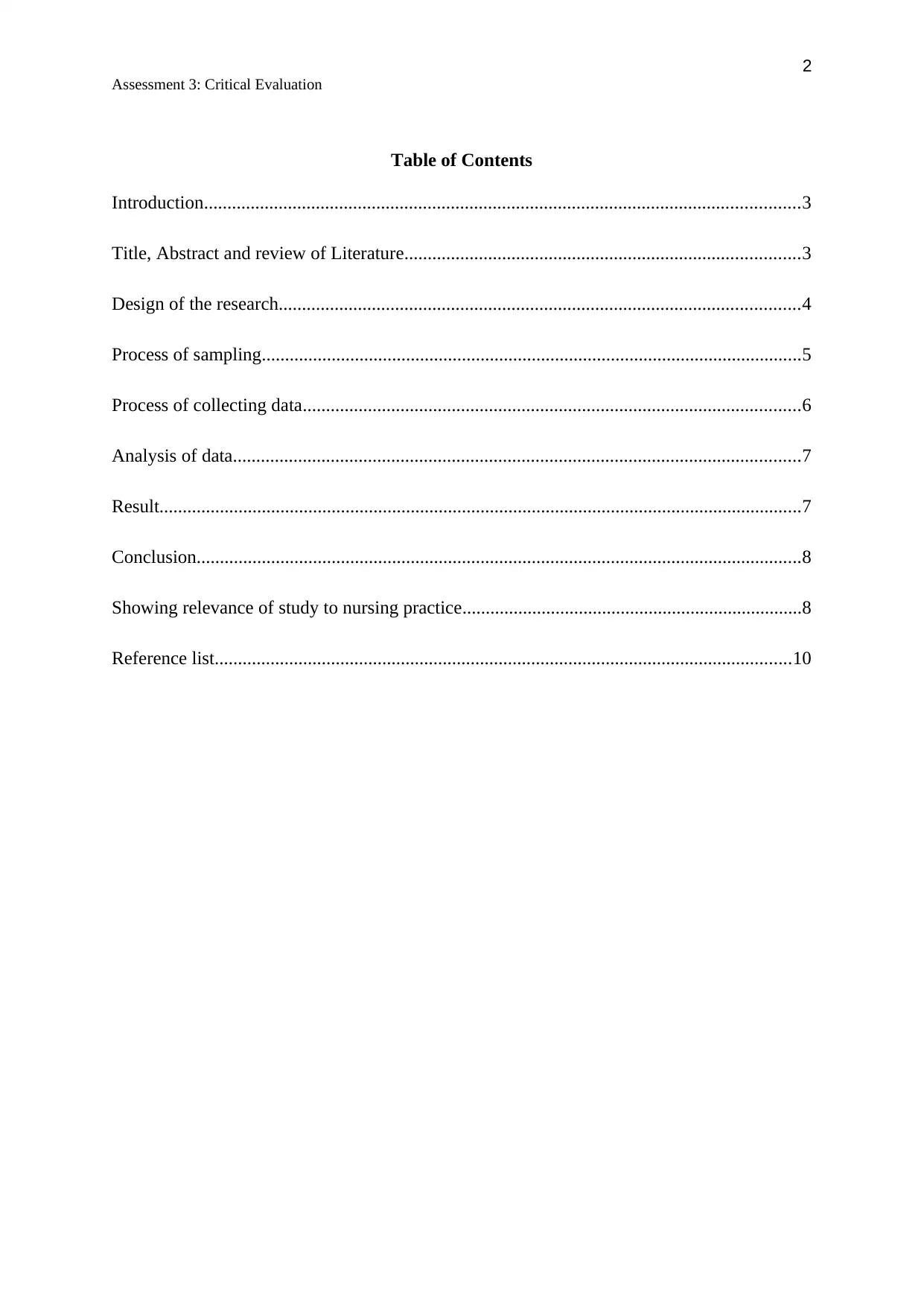
2
Assessment 3: Critical Evaluation
Table of Contents
Introduction................................................................................................................................3
Title, Abstract and review of Literature.....................................................................................3
Design of the research................................................................................................................4
Process of sampling....................................................................................................................5
Process of collecting data...........................................................................................................6
Analysis of data..........................................................................................................................7
Result..........................................................................................................................................7
Conclusion..................................................................................................................................8
Showing relevance of study to nursing practice.........................................................................8
Reference list............................................................................................................................10
Assessment 3: Critical Evaluation
Table of Contents
Introduction................................................................................................................................3
Title, Abstract and review of Literature.....................................................................................3
Design of the research................................................................................................................4
Process of sampling....................................................................................................................5
Process of collecting data...........................................................................................................6
Analysis of data..........................................................................................................................7
Result..........................................................................................................................................7
Conclusion..................................................................................................................................8
Showing relevance of study to nursing practice.........................................................................8
Reference list............................................................................................................................10
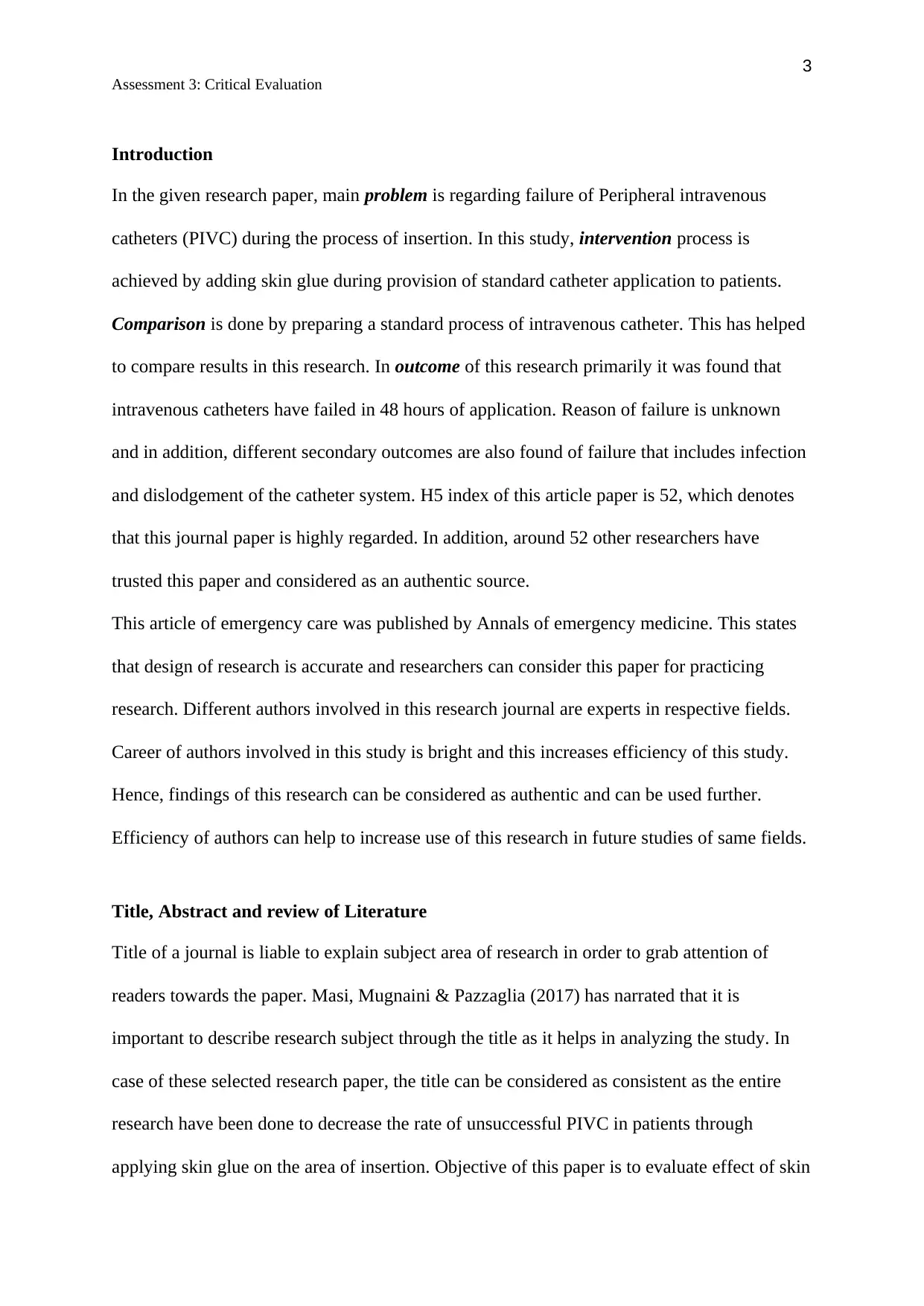
3
Assessment 3: Critical Evaluation
Introduction
In the given research paper, main problem is regarding failure of Peripheral intravenous
catheters (PIVC) during the process of insertion. In this study, intervention process is
achieved by adding skin glue during provision of standard catheter application to patients.
Comparison is done by preparing a standard process of intravenous catheter. This has helped
to compare results in this research. In outcome of this research primarily it was found that
intravenous catheters have failed in 48 hours of application. Reason of failure is unknown
and in addition, different secondary outcomes are also found of failure that includes infection
and dislodgement of the catheter system. H5 index of this article paper is 52, which denotes
that this journal paper is highly regarded. In addition, around 52 other researchers have
trusted this paper and considered as an authentic source.
This article of emergency care was published by Annals of emergency medicine. This states
that design of research is accurate and researchers can consider this paper for practicing
research. Different authors involved in this research journal are experts in respective fields.
Career of authors involved in this study is bright and this increases efficiency of this study.
Hence, findings of this research can be considered as authentic and can be used further.
Efficiency of authors can help to increase use of this research in future studies of same fields.
Title, Abstract and review of Literature
Title of a journal is liable to explain subject area of research in order to grab attention of
readers towards the paper. Masi, Mugnaini & Pazzaglia (2017) has narrated that it is
important to describe research subject through the title as it helps in analyzing the study. In
case of these selected research paper, the title can be considered as consistent as the entire
research have been done to decrease the rate of unsuccessful PIVC in patients through
applying skin glue on the area of insertion. Objective of this paper is to evaluate effect of skin
Assessment 3: Critical Evaluation
Introduction
In the given research paper, main problem is regarding failure of Peripheral intravenous
catheters (PIVC) during the process of insertion. In this study, intervention process is
achieved by adding skin glue during provision of standard catheter application to patients.
Comparison is done by preparing a standard process of intravenous catheter. This has helped
to compare results in this research. In outcome of this research primarily it was found that
intravenous catheters have failed in 48 hours of application. Reason of failure is unknown
and in addition, different secondary outcomes are also found of failure that includes infection
and dislodgement of the catheter system. H5 index of this article paper is 52, which denotes
that this journal paper is highly regarded. In addition, around 52 other researchers have
trusted this paper and considered as an authentic source.
This article of emergency care was published by Annals of emergency medicine. This states
that design of research is accurate and researchers can consider this paper for practicing
research. Different authors involved in this research journal are experts in respective fields.
Career of authors involved in this study is bright and this increases efficiency of this study.
Hence, findings of this research can be considered as authentic and can be used further.
Efficiency of authors can help to increase use of this research in future studies of same fields.
Title, Abstract and review of Literature
Title of a journal is liable to explain subject area of research in order to grab attention of
readers towards the paper. Masi, Mugnaini & Pazzaglia (2017) has narrated that it is
important to describe research subject through the title as it helps in analyzing the study. In
case of these selected research paper, the title can be considered as consistent as the entire
research have been done to decrease the rate of unsuccessful PIVC in patients through
applying skin glue on the area of insertion. Objective of this paper is to evaluate effect of skin
⊘ This is a preview!⊘
Do you want full access?
Subscribe today to unlock all pages.

Trusted by 1+ million students worldwide
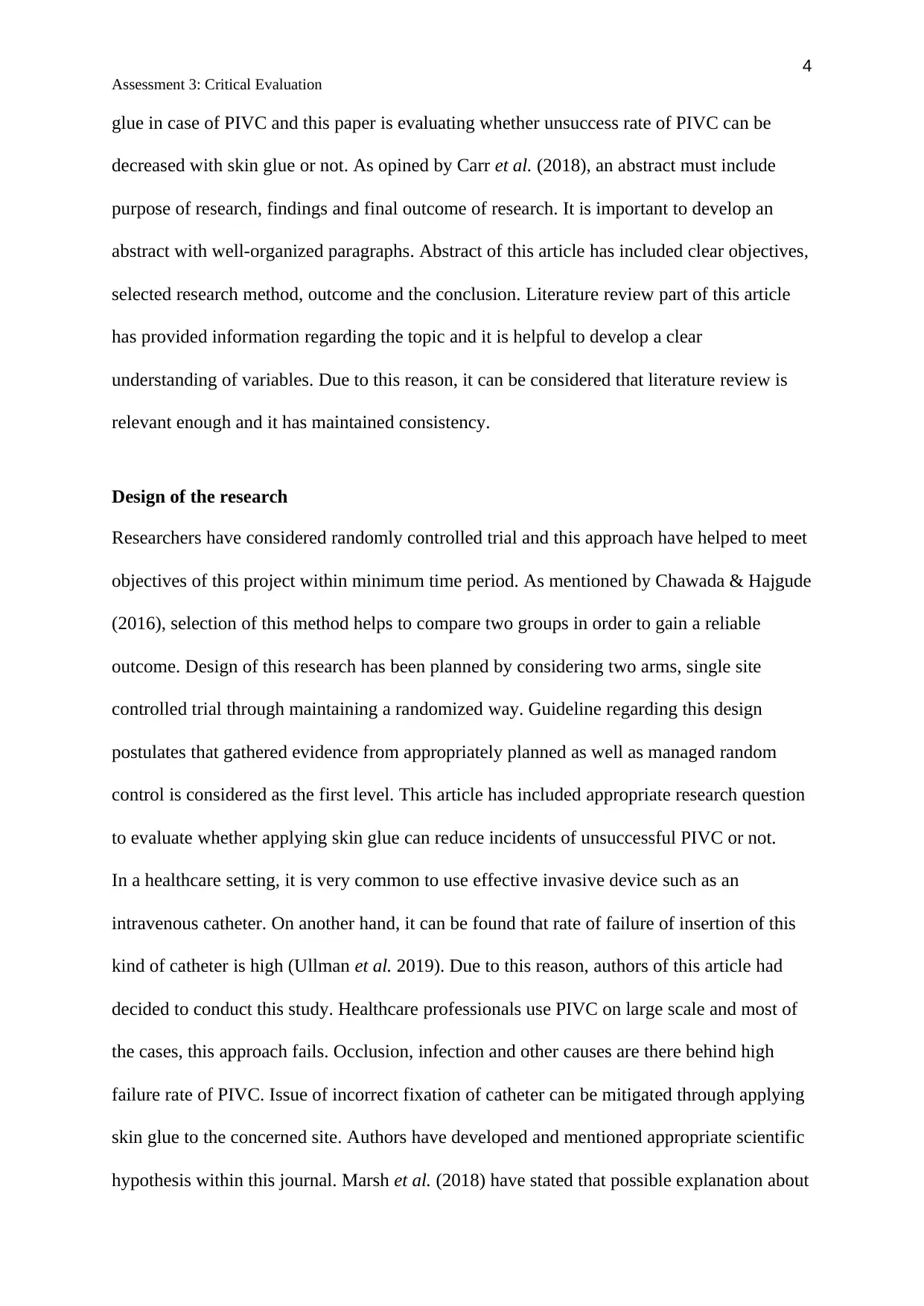
4
Assessment 3: Critical Evaluation
glue in case of PIVC and this paper is evaluating whether unsuccess rate of PIVC can be
decreased with skin glue or not. As opined by Carr et al. (2018), an abstract must include
purpose of research, findings and final outcome of research. It is important to develop an
abstract with well-organized paragraphs. Abstract of this article has included clear objectives,
selected research method, outcome and the conclusion. Literature review part of this article
has provided information regarding the topic and it is helpful to develop a clear
understanding of variables. Due to this reason, it can be considered that literature review is
relevant enough and it has maintained consistency.
Design of the research
Researchers have considered randomly controlled trial and this approach have helped to meet
objectives of this project within minimum time period. As mentioned by Chawada & Hajgude
(2016), selection of this method helps to compare two groups in order to gain a reliable
outcome. Design of this research has been planned by considering two arms, single site
controlled trial through maintaining a randomized way. Guideline regarding this design
postulates that gathered evidence from appropriately planned as well as managed random
control is considered as the first level. This article has included appropriate research question
to evaluate whether applying skin glue can reduce incidents of unsuccessful PIVC or not.
In a healthcare setting, it is very common to use effective invasive device such as an
intravenous catheter. On another hand, it can be found that rate of failure of insertion of this
kind of catheter is high (Ullman et al. 2019). Due to this reason, authors of this article had
decided to conduct this study. Healthcare professionals use PIVC on large scale and most of
the cases, this approach fails. Occlusion, infection and other causes are there behind high
failure rate of PIVC. Issue of incorrect fixation of catheter can be mitigated through applying
skin glue to the concerned site. Authors have developed and mentioned appropriate scientific
hypothesis within this journal. Marsh et al. (2018) have stated that possible explanation about
Assessment 3: Critical Evaluation
glue in case of PIVC and this paper is evaluating whether unsuccess rate of PIVC can be
decreased with skin glue or not. As opined by Carr et al. (2018), an abstract must include
purpose of research, findings and final outcome of research. It is important to develop an
abstract with well-organized paragraphs. Abstract of this article has included clear objectives,
selected research method, outcome and the conclusion. Literature review part of this article
has provided information regarding the topic and it is helpful to develop a clear
understanding of variables. Due to this reason, it can be considered that literature review is
relevant enough and it has maintained consistency.
Design of the research
Researchers have considered randomly controlled trial and this approach have helped to meet
objectives of this project within minimum time period. As mentioned by Chawada & Hajgude
(2016), selection of this method helps to compare two groups in order to gain a reliable
outcome. Design of this research has been planned by considering two arms, single site
controlled trial through maintaining a randomized way. Guideline regarding this design
postulates that gathered evidence from appropriately planned as well as managed random
control is considered as the first level. This article has included appropriate research question
to evaluate whether applying skin glue can reduce incidents of unsuccessful PIVC or not.
In a healthcare setting, it is very common to use effective invasive device such as an
intravenous catheter. On another hand, it can be found that rate of failure of insertion of this
kind of catheter is high (Ullman et al. 2019). Due to this reason, authors of this article had
decided to conduct this study. Healthcare professionals use PIVC on large scale and most of
the cases, this approach fails. Occlusion, infection and other causes are there behind high
failure rate of PIVC. Issue of incorrect fixation of catheter can be mitigated through applying
skin glue to the concerned site. Authors have developed and mentioned appropriate scientific
hypothesis within this journal. Marsh et al. (2018) have stated that possible explanation about
Paraphrase This Document
Need a fresh take? Get an instant paraphrase of this document with our AI Paraphraser
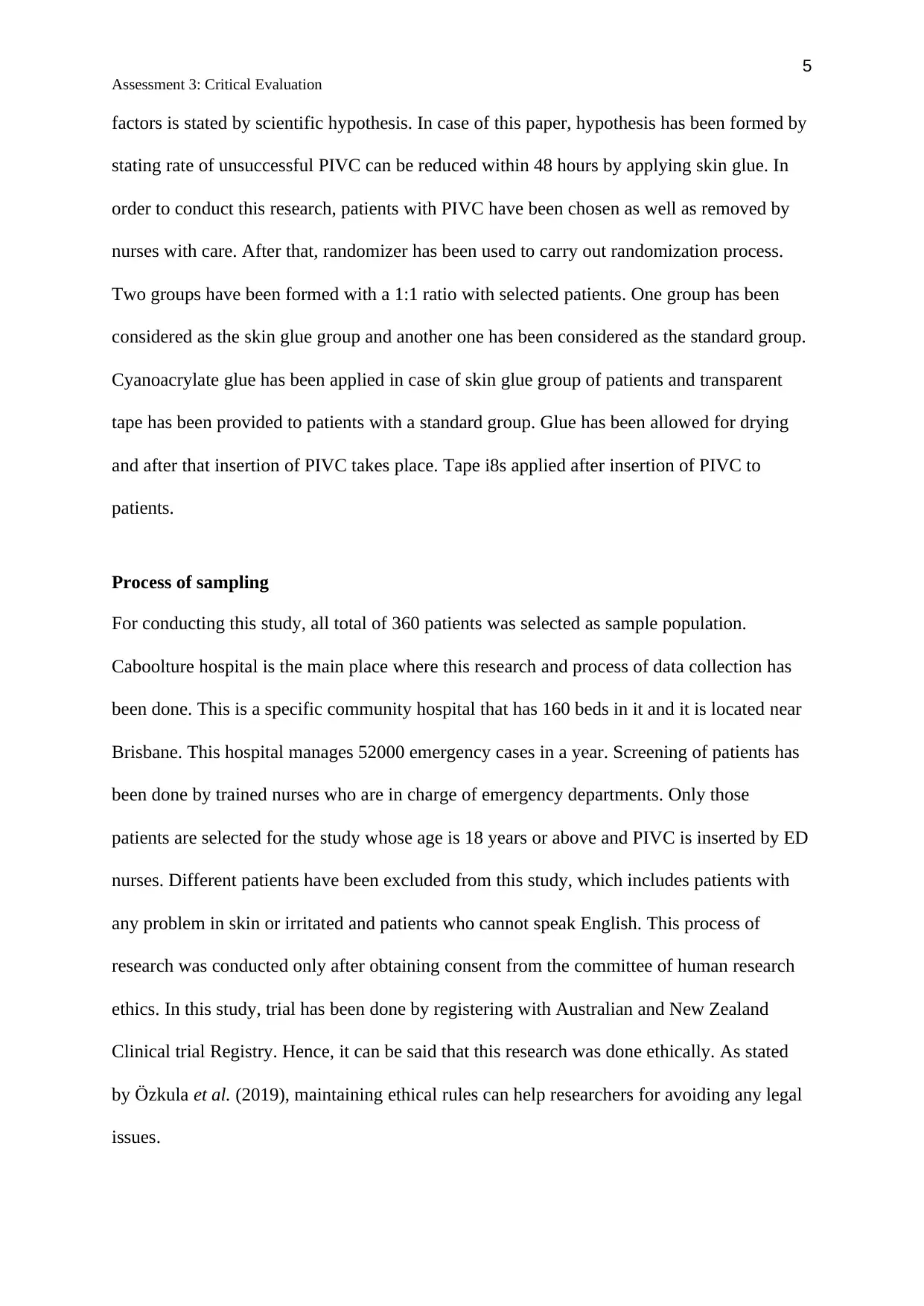
5
Assessment 3: Critical Evaluation
factors is stated by scientific hypothesis. In case of this paper, hypothesis has been formed by
stating rate of unsuccessful PIVC can be reduced within 48 hours by applying skin glue. In
order to conduct this research, patients with PIVC have been chosen as well as removed by
nurses with care. After that, randomizer has been used to carry out randomization process.
Two groups have been formed with a 1:1 ratio with selected patients. One group has been
considered as the skin glue group and another one has been considered as the standard group.
Cyanoacrylate glue has been applied in case of skin glue group of patients and transparent
tape has been provided to patients with a standard group. Glue has been allowed for drying
and after that insertion of PIVC takes place. Tape i8s applied after insertion of PIVC to
patients.
Process of sampling
For conducting this study, all total of 360 patients was selected as sample population.
Caboolture hospital is the main place where this research and process of data collection has
been done. This is a specific community hospital that has 160 beds in it and it is located near
Brisbane. This hospital manages 52000 emergency cases in a year. Screening of patients has
been done by trained nurses who are in charge of emergency departments. Only those
patients are selected for the study whose age is 18 years or above and PIVC is inserted by ED
nurses. Different patients have been excluded from this study, which includes patients with
any problem in skin or irritated and patients who cannot speak English. This process of
research was conducted only after obtaining consent from the committee of human research
ethics. In this study, trial has been done by registering with Australian and New Zealand
Clinical trial Registry. Hence, it can be said that this research was done ethically. As stated
by Özkula et al. (2019), maintaining ethical rules can help researchers for avoiding any legal
issues.
Assessment 3: Critical Evaluation
factors is stated by scientific hypothesis. In case of this paper, hypothesis has been formed by
stating rate of unsuccessful PIVC can be reduced within 48 hours by applying skin glue. In
order to conduct this research, patients with PIVC have been chosen as well as removed by
nurses with care. After that, randomizer has been used to carry out randomization process.
Two groups have been formed with a 1:1 ratio with selected patients. One group has been
considered as the skin glue group and another one has been considered as the standard group.
Cyanoacrylate glue has been applied in case of skin glue group of patients and transparent
tape has been provided to patients with a standard group. Glue has been allowed for drying
and after that insertion of PIVC takes place. Tape i8s applied after insertion of PIVC to
patients.
Process of sampling
For conducting this study, all total of 360 patients was selected as sample population.
Caboolture hospital is the main place where this research and process of data collection has
been done. This is a specific community hospital that has 160 beds in it and it is located near
Brisbane. This hospital manages 52000 emergency cases in a year. Screening of patients has
been done by trained nurses who are in charge of emergency departments. Only those
patients are selected for the study whose age is 18 years or above and PIVC is inserted by ED
nurses. Different patients have been excluded from this study, which includes patients with
any problem in skin or irritated and patients who cannot speak English. This process of
research was conducted only after obtaining consent from the committee of human research
ethics. In this study, trial has been done by registering with Australian and New Zealand
Clinical trial Registry. Hence, it can be said that this research was done ethically. As stated
by Özkula et al. (2019), maintaining ethical rules can help researchers for avoiding any legal
issues.
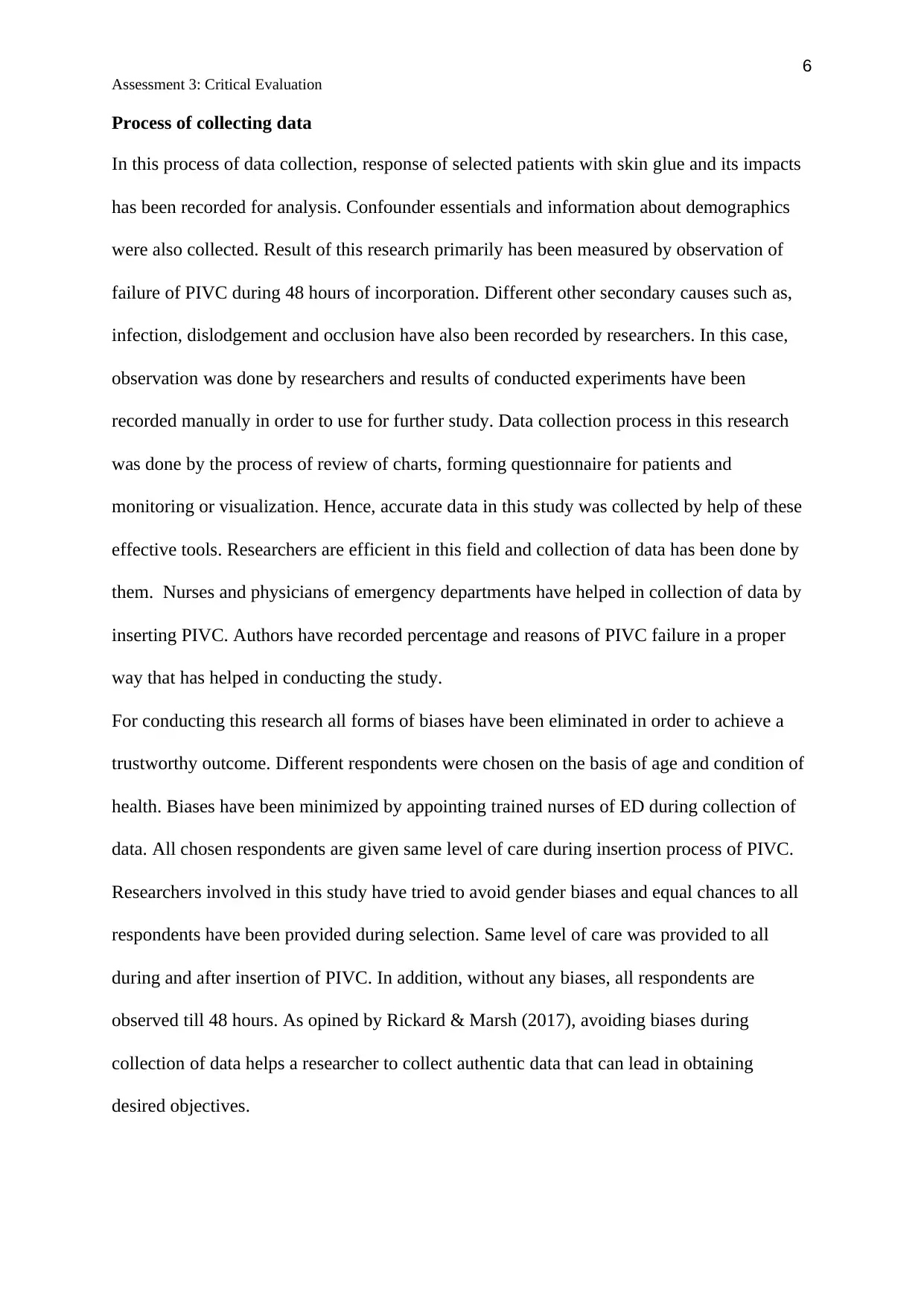
6
Assessment 3: Critical Evaluation
Process of collecting data
In this process of data collection, response of selected patients with skin glue and its impacts
has been recorded for analysis. Confounder essentials and information about demographics
were also collected. Result of this research primarily has been measured by observation of
failure of PIVC during 48 hours of incorporation. Different other secondary causes such as,
infection, dislodgement and occlusion have also been recorded by researchers. In this case,
observation was done by researchers and results of conducted experiments have been
recorded manually in order to use for further study. Data collection process in this research
was done by the process of review of charts, forming questionnaire for patients and
monitoring or visualization. Hence, accurate data in this study was collected by help of these
effective tools. Researchers are efficient in this field and collection of data has been done by
them. Nurses and physicians of emergency departments have helped in collection of data by
inserting PIVC. Authors have recorded percentage and reasons of PIVC failure in a proper
way that has helped in conducting the study.
For conducting this research all forms of biases have been eliminated in order to achieve a
trustworthy outcome. Different respondents were chosen on the basis of age and condition of
health. Biases have been minimized by appointing trained nurses of ED during collection of
data. All chosen respondents are given same level of care during insertion process of PIVC.
Researchers involved in this study have tried to avoid gender biases and equal chances to all
respondents have been provided during selection. Same level of care was provided to all
during and after insertion of PIVC. In addition, without any biases, all respondents are
observed till 48 hours. As opined by Rickard & Marsh (2017), avoiding biases during
collection of data helps a researcher to collect authentic data that can lead in obtaining
desired objectives.
Assessment 3: Critical Evaluation
Process of collecting data
In this process of data collection, response of selected patients with skin glue and its impacts
has been recorded for analysis. Confounder essentials and information about demographics
were also collected. Result of this research primarily has been measured by observation of
failure of PIVC during 48 hours of incorporation. Different other secondary causes such as,
infection, dislodgement and occlusion have also been recorded by researchers. In this case,
observation was done by researchers and results of conducted experiments have been
recorded manually in order to use for further study. Data collection process in this research
was done by the process of review of charts, forming questionnaire for patients and
monitoring or visualization. Hence, accurate data in this study was collected by help of these
effective tools. Researchers are efficient in this field and collection of data has been done by
them. Nurses and physicians of emergency departments have helped in collection of data by
inserting PIVC. Authors have recorded percentage and reasons of PIVC failure in a proper
way that has helped in conducting the study.
For conducting this research all forms of biases have been eliminated in order to achieve a
trustworthy outcome. Different respondents were chosen on the basis of age and condition of
health. Biases have been minimized by appointing trained nurses of ED during collection of
data. All chosen respondents are given same level of care during insertion process of PIVC.
Researchers involved in this study have tried to avoid gender biases and equal chances to all
respondents have been provided during selection. Same level of care was provided to all
during and after insertion of PIVC. In addition, without any biases, all respondents are
observed till 48 hours. As opined by Rickard & Marsh (2017), avoiding biases during
collection of data helps a researcher to collect authentic data that can lead in obtaining
desired objectives.
⊘ This is a preview!⊘
Do you want full access?
Subscribe today to unlock all pages.

Trusted by 1+ million students worldwide
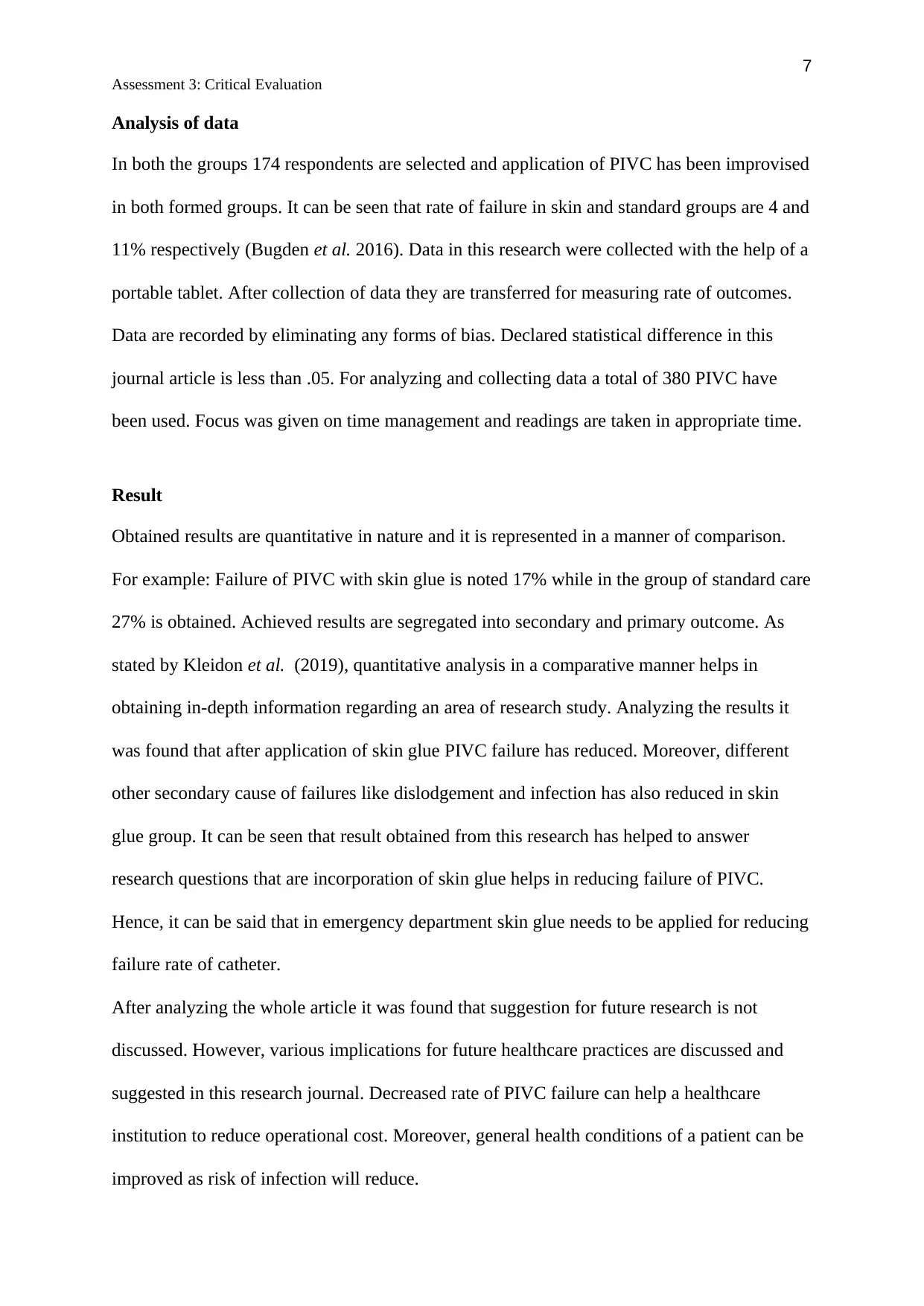
7
Assessment 3: Critical Evaluation
Analysis of data
In both the groups 174 respondents are selected and application of PIVC has been improvised
in both formed groups. It can be seen that rate of failure in skin and standard groups are 4 and
11% respectively (Bugden et al. 2016). Data in this research were collected with the help of a
portable tablet. After collection of data they are transferred for measuring rate of outcomes.
Data are recorded by eliminating any forms of bias. Declared statistical difference in this
journal article is less than .05. For analyzing and collecting data a total of 380 PIVC have
been used. Focus was given on time management and readings are taken in appropriate time.
Result
Obtained results are quantitative in nature and it is represented in a manner of comparison.
For example: Failure of PIVC with skin glue is noted 17% while in the group of standard care
27% is obtained. Achieved results are segregated into secondary and primary outcome. As
stated by Kleidon et al. (2019), quantitative analysis in a comparative manner helps in
obtaining in-depth information regarding an area of research study. Analyzing the results it
was found that after application of skin glue PIVC failure has reduced. Moreover, different
other secondary cause of failures like dislodgement and infection has also reduced in skin
glue group. It can be seen that result obtained from this research has helped to answer
research questions that are incorporation of skin glue helps in reducing failure of PIVC.
Hence, it can be said that in emergency department skin glue needs to be applied for reducing
failure rate of catheter.
After analyzing the whole article it was found that suggestion for future research is not
discussed. However, various implications for future healthcare practices are discussed and
suggested in this research journal. Decreased rate of PIVC failure can help a healthcare
institution to reduce operational cost. Moreover, general health conditions of a patient can be
improved as risk of infection will reduce.
Assessment 3: Critical Evaluation
Analysis of data
In both the groups 174 respondents are selected and application of PIVC has been improvised
in both formed groups. It can be seen that rate of failure in skin and standard groups are 4 and
11% respectively (Bugden et al. 2016). Data in this research were collected with the help of a
portable tablet. After collection of data they are transferred for measuring rate of outcomes.
Data are recorded by eliminating any forms of bias. Declared statistical difference in this
journal article is less than .05. For analyzing and collecting data a total of 380 PIVC have
been used. Focus was given on time management and readings are taken in appropriate time.
Result
Obtained results are quantitative in nature and it is represented in a manner of comparison.
For example: Failure of PIVC with skin glue is noted 17% while in the group of standard care
27% is obtained. Achieved results are segregated into secondary and primary outcome. As
stated by Kleidon et al. (2019), quantitative analysis in a comparative manner helps in
obtaining in-depth information regarding an area of research study. Analyzing the results it
was found that after application of skin glue PIVC failure has reduced. Moreover, different
other secondary cause of failures like dislodgement and infection has also reduced in skin
glue group. It can be seen that result obtained from this research has helped to answer
research questions that are incorporation of skin glue helps in reducing failure of PIVC.
Hence, it can be said that in emergency department skin glue needs to be applied for reducing
failure rate of catheter.
After analyzing the whole article it was found that suggestion for future research is not
discussed. However, various implications for future healthcare practices are discussed and
suggested in this research journal. Decreased rate of PIVC failure can help a healthcare
institution to reduce operational cost. Moreover, general health conditions of a patient can be
improved as risk of infection will reduce.
Paraphrase This Document
Need a fresh take? Get an instant paraphrase of this document with our AI Paraphraser
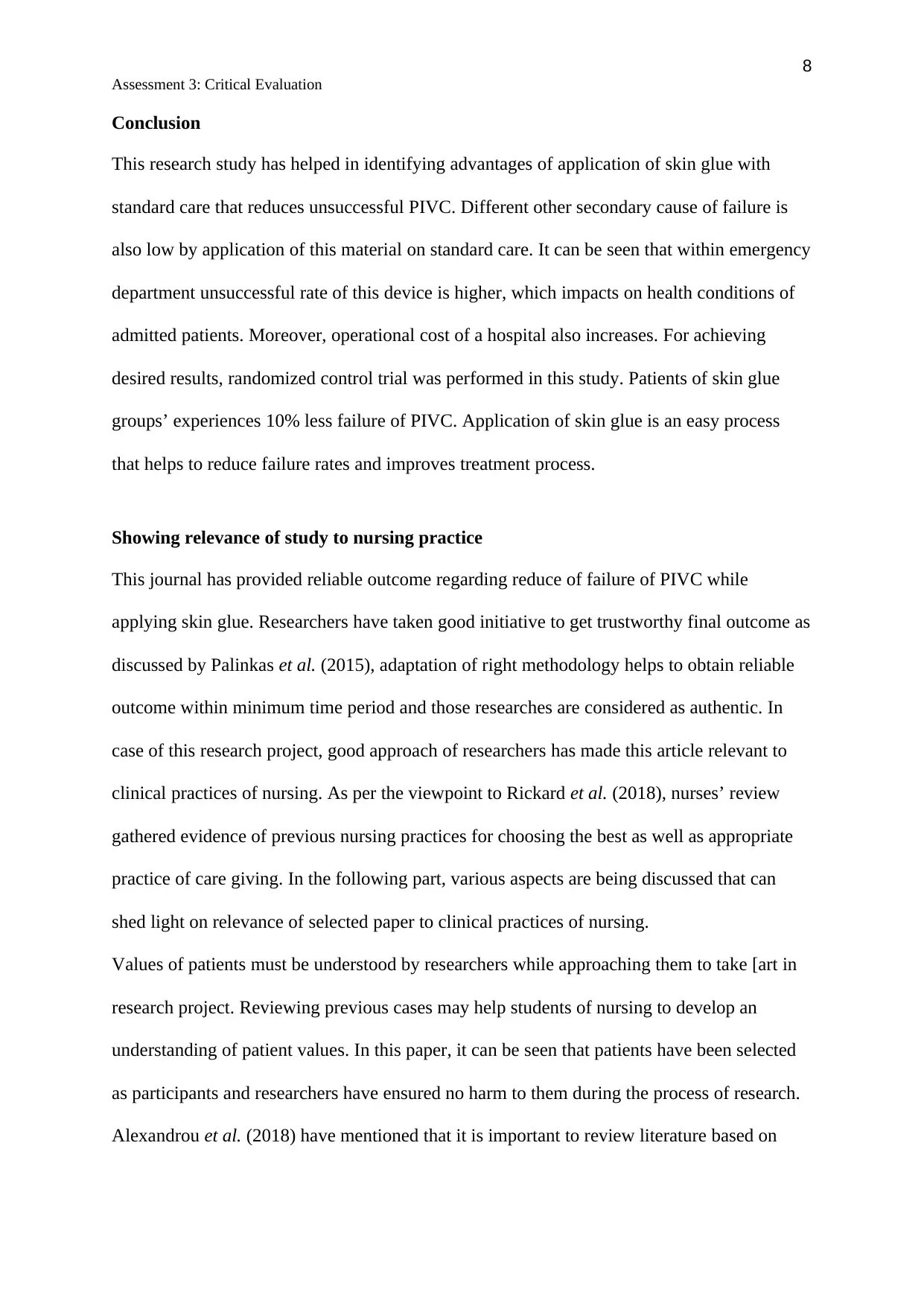
8
Assessment 3: Critical Evaluation
Conclusion
This research study has helped in identifying advantages of application of skin glue with
standard care that reduces unsuccessful PIVC. Different other secondary cause of failure is
also low by application of this material on standard care. It can be seen that within emergency
department unsuccessful rate of this device is higher, which impacts on health conditions of
admitted patients. Moreover, operational cost of a hospital also increases. For achieving
desired results, randomized control trial was performed in this study. Patients of skin glue
groups’ experiences 10% less failure of PIVC. Application of skin glue is an easy process
that helps to reduce failure rates and improves treatment process.
Showing relevance of study to nursing practice
This journal has provided reliable outcome regarding reduce of failure of PIVC while
applying skin glue. Researchers have taken good initiative to get trustworthy final outcome as
discussed by Palinkas et al. (2015), adaptation of right methodology helps to obtain reliable
outcome within minimum time period and those researches are considered as authentic. In
case of this research project, good approach of researchers has made this article relevant to
clinical practices of nursing. As per the viewpoint to Rickard et al. (2018), nurses’ review
gathered evidence of previous nursing practices for choosing the best as well as appropriate
practice of care giving. In the following part, various aspects are being discussed that can
shed light on relevance of selected paper to clinical practices of nursing.
Values of patients must be understood by researchers while approaching them to take [art in
research project. Reviewing previous cases may help students of nursing to develop an
understanding of patient values. In this paper, it can be seen that patients have been selected
as participants and researchers have ensured no harm to them during the process of research.
Alexandrou et al. (2018) have mentioned that it is important to review literature based on
Assessment 3: Critical Evaluation
Conclusion
This research study has helped in identifying advantages of application of skin glue with
standard care that reduces unsuccessful PIVC. Different other secondary cause of failure is
also low by application of this material on standard care. It can be seen that within emergency
department unsuccessful rate of this device is higher, which impacts on health conditions of
admitted patients. Moreover, operational cost of a hospital also increases. For achieving
desired results, randomized control trial was performed in this study. Patients of skin glue
groups’ experiences 10% less failure of PIVC. Application of skin glue is an easy process
that helps to reduce failure rates and improves treatment process.
Showing relevance of study to nursing practice
This journal has provided reliable outcome regarding reduce of failure of PIVC while
applying skin glue. Researchers have taken good initiative to get trustworthy final outcome as
discussed by Palinkas et al. (2015), adaptation of right methodology helps to obtain reliable
outcome within minimum time period and those researches are considered as authentic. In
case of this research project, good approach of researchers has made this article relevant to
clinical practices of nursing. As per the viewpoint to Rickard et al. (2018), nurses’ review
gathered evidence of previous nursing practices for choosing the best as well as appropriate
practice of care giving. In the following part, various aspects are being discussed that can
shed light on relevance of selected paper to clinical practices of nursing.
Values of patients must be understood by researchers while approaching them to take [art in
research project. Reviewing previous cases may help students of nursing to develop an
understanding of patient values. In this paper, it can be seen that patients have been selected
as participants and researchers have ensured no harm to them during the process of research.
Alexandrou et al. (2018) have mentioned that it is important to review literature based on
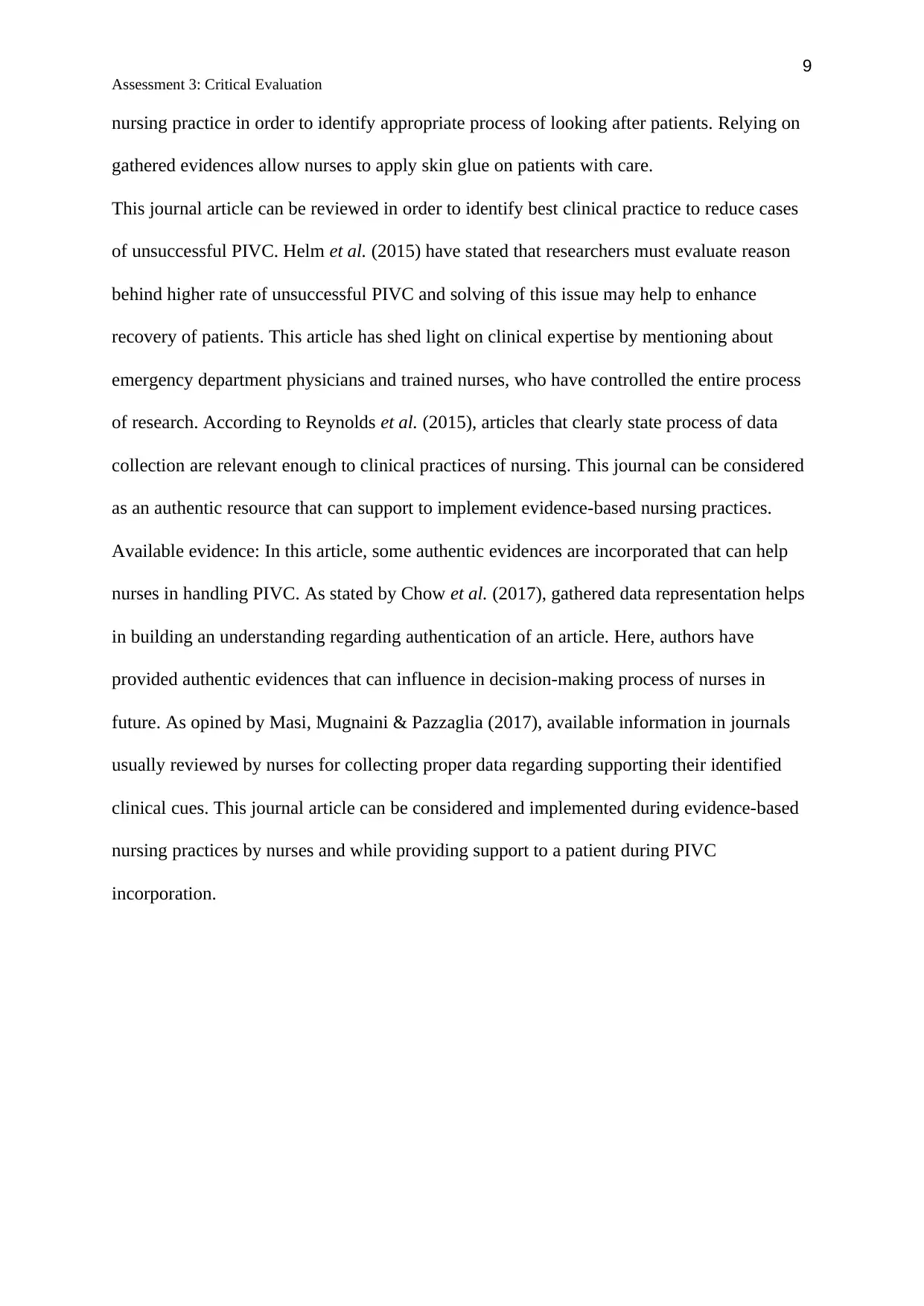
9
Assessment 3: Critical Evaluation
nursing practice in order to identify appropriate process of looking after patients. Relying on
gathered evidences allow nurses to apply skin glue on patients with care.
This journal article can be reviewed in order to identify best clinical practice to reduce cases
of unsuccessful PIVC. Helm et al. (2015) have stated that researchers must evaluate reason
behind higher rate of unsuccessful PIVC and solving of this issue may help to enhance
recovery of patients. This article has shed light on clinical expertise by mentioning about
emergency department physicians and trained nurses, who have controlled the entire process
of research. According to Reynolds et al. (2015), articles that clearly state process of data
collection are relevant enough to clinical practices of nursing. This journal can be considered
as an authentic resource that can support to implement evidence-based nursing practices.
Available evidence: In this article, some authentic evidences are incorporated that can help
nurses in handling PIVC. As stated by Chow et al. (2017), gathered data representation helps
in building an understanding regarding authentication of an article. Here, authors have
provided authentic evidences that can influence in decision-making process of nurses in
future. As opined by Masi, Mugnaini & Pazzaglia (2017), available information in journals
usually reviewed by nurses for collecting proper data regarding supporting their identified
clinical cues. This journal article can be considered and implemented during evidence-based
nursing practices by nurses and while providing support to a patient during PIVC
incorporation.
Assessment 3: Critical Evaluation
nursing practice in order to identify appropriate process of looking after patients. Relying on
gathered evidences allow nurses to apply skin glue on patients with care.
This journal article can be reviewed in order to identify best clinical practice to reduce cases
of unsuccessful PIVC. Helm et al. (2015) have stated that researchers must evaluate reason
behind higher rate of unsuccessful PIVC and solving of this issue may help to enhance
recovery of patients. This article has shed light on clinical expertise by mentioning about
emergency department physicians and trained nurses, who have controlled the entire process
of research. According to Reynolds et al. (2015), articles that clearly state process of data
collection are relevant enough to clinical practices of nursing. This journal can be considered
as an authentic resource that can support to implement evidence-based nursing practices.
Available evidence: In this article, some authentic evidences are incorporated that can help
nurses in handling PIVC. As stated by Chow et al. (2017), gathered data representation helps
in building an understanding regarding authentication of an article. Here, authors have
provided authentic evidences that can influence in decision-making process of nurses in
future. As opined by Masi, Mugnaini & Pazzaglia (2017), available information in journals
usually reviewed by nurses for collecting proper data regarding supporting their identified
clinical cues. This journal article can be considered and implemented during evidence-based
nursing practices by nurses and while providing support to a patient during PIVC
incorporation.
⊘ This is a preview!⊘
Do you want full access?
Subscribe today to unlock all pages.

Trusted by 1+ million students worldwide
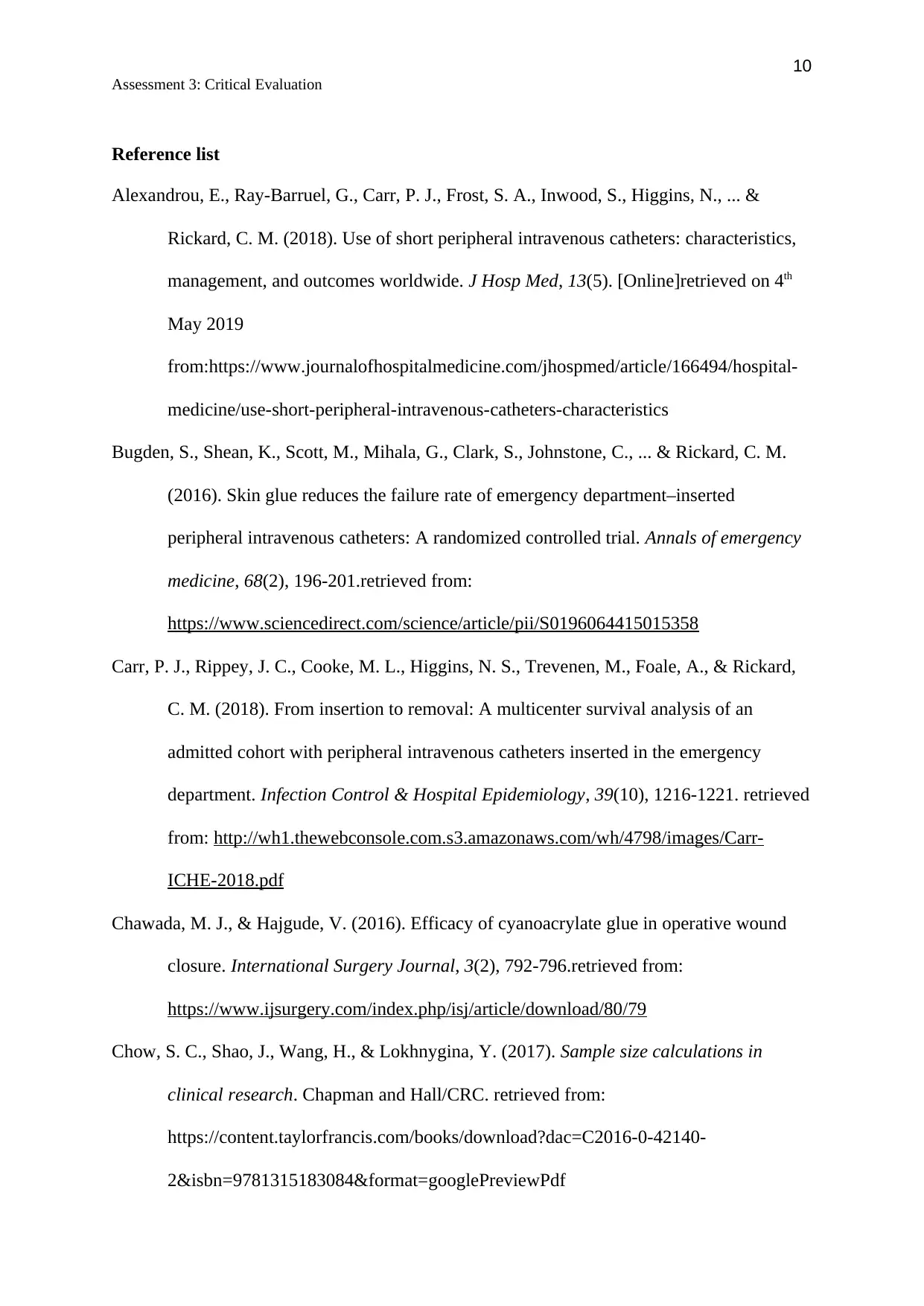
10
Assessment 3: Critical Evaluation
Reference list
Alexandrou, E., Ray-Barruel, G., Carr, P. J., Frost, S. A., Inwood, S., Higgins, N., ... &
Rickard, C. M. (2018). Use of short peripheral intravenous catheters: characteristics,
management, and outcomes worldwide. J Hosp Med, 13(5). [Online]retrieved on 4th
May 2019
from:https://www.journalofhospitalmedicine.com/jhospmed/article/166494/hospital-
medicine/use-short-peripheral-intravenous-catheters-characteristics
Bugden, S., Shean, K., Scott, M., Mihala, G., Clark, S., Johnstone, C., ... & Rickard, C. M.
(2016). Skin glue reduces the failure rate of emergency department–inserted
peripheral intravenous catheters: A randomized controlled trial. Annals of emergency
medicine, 68(2), 196-201.retrieved from:
https://www.sciencedirect.com/science/article/pii/S0196064415015358
Carr, P. J., Rippey, J. C., Cooke, M. L., Higgins, N. S., Trevenen, M., Foale, A., & Rickard,
C. M. (2018). From insertion to removal: A multicenter survival analysis of an
admitted cohort with peripheral intravenous catheters inserted in the emergency
department. Infection Control & Hospital Epidemiology, 39(10), 1216-1221. retrieved
from: http://wh1.thewebconsole.com.s3.amazonaws.com/wh/4798/images/Carr-
ICHE-2018.pdf
Chawada, M. J., & Hajgude, V. (2016). Efficacy of cyanoacrylate glue in operative wound
closure. International Surgery Journal, 3(2), 792-796.retrieved from:
https://www.ijsurgery.com/index.php/isj/article/download/80/79
Chow, S. C., Shao, J., Wang, H., & Lokhnygina, Y. (2017). Sample size calculations in
clinical research. Chapman and Hall/CRC. retrieved from:
https://content.taylorfrancis.com/books/download?dac=C2016-0-42140-
2&isbn=9781315183084&format=googlePreviewPdf
Assessment 3: Critical Evaluation
Reference list
Alexandrou, E., Ray-Barruel, G., Carr, P. J., Frost, S. A., Inwood, S., Higgins, N., ... &
Rickard, C. M. (2018). Use of short peripheral intravenous catheters: characteristics,
management, and outcomes worldwide. J Hosp Med, 13(5). [Online]retrieved on 4th
May 2019
from:https://www.journalofhospitalmedicine.com/jhospmed/article/166494/hospital-
medicine/use-short-peripheral-intravenous-catheters-characteristics
Bugden, S., Shean, K., Scott, M., Mihala, G., Clark, S., Johnstone, C., ... & Rickard, C. M.
(2016). Skin glue reduces the failure rate of emergency department–inserted
peripheral intravenous catheters: A randomized controlled trial. Annals of emergency
medicine, 68(2), 196-201.retrieved from:
https://www.sciencedirect.com/science/article/pii/S0196064415015358
Carr, P. J., Rippey, J. C., Cooke, M. L., Higgins, N. S., Trevenen, M., Foale, A., & Rickard,
C. M. (2018). From insertion to removal: A multicenter survival analysis of an
admitted cohort with peripheral intravenous catheters inserted in the emergency
department. Infection Control & Hospital Epidemiology, 39(10), 1216-1221. retrieved
from: http://wh1.thewebconsole.com.s3.amazonaws.com/wh/4798/images/Carr-
ICHE-2018.pdf
Chawada, M. J., & Hajgude, V. (2016). Efficacy of cyanoacrylate glue in operative wound
closure. International Surgery Journal, 3(2), 792-796.retrieved from:
https://www.ijsurgery.com/index.php/isj/article/download/80/79
Chow, S. C., Shao, J., Wang, H., & Lokhnygina, Y. (2017). Sample size calculations in
clinical research. Chapman and Hall/CRC. retrieved from:
https://content.taylorfrancis.com/books/download?dac=C2016-0-42140-
2&isbn=9781315183084&format=googlePreviewPdf
Paraphrase This Document
Need a fresh take? Get an instant paraphrase of this document with our AI Paraphraser
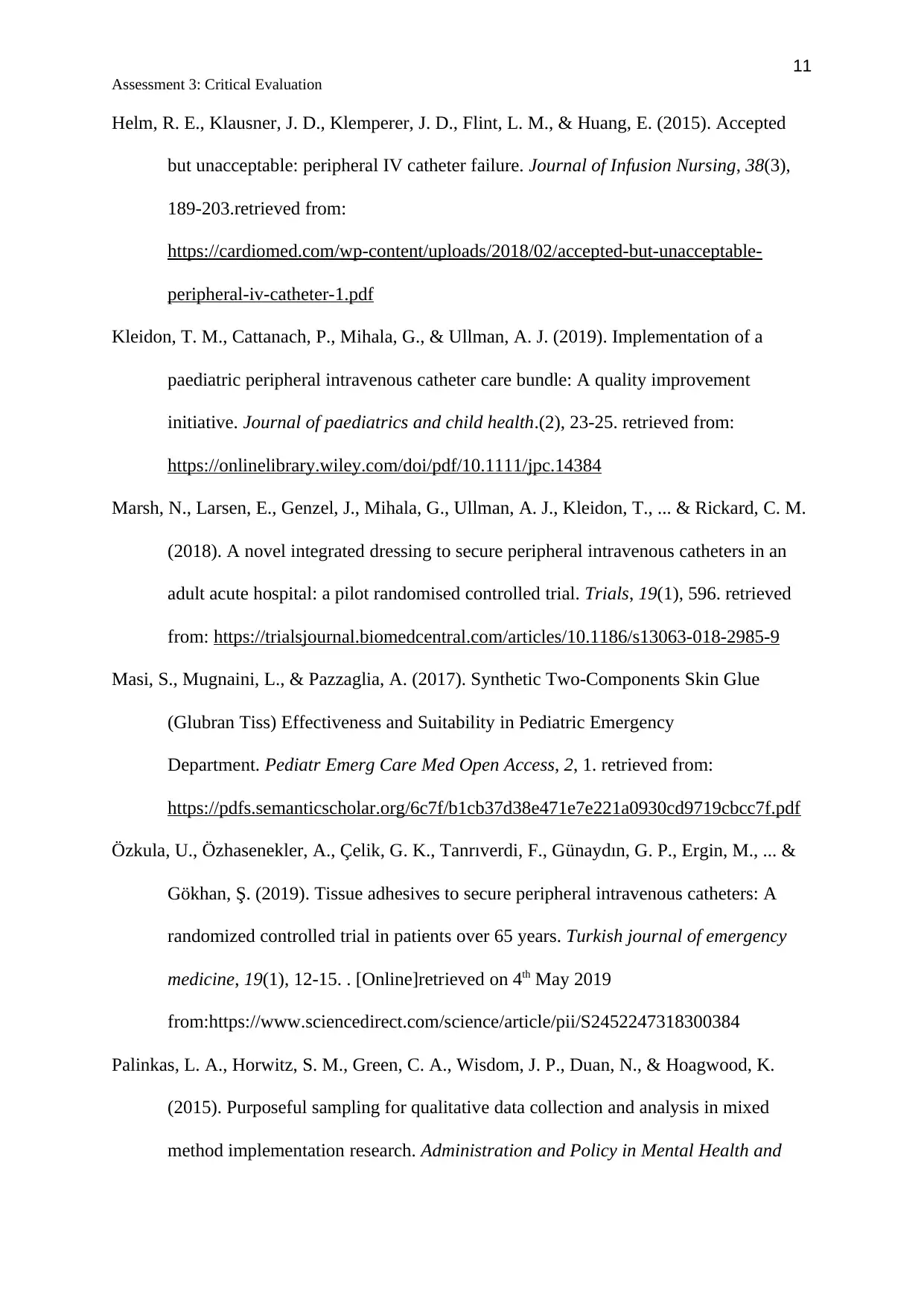
11
Assessment 3: Critical Evaluation
Helm, R. E., Klausner, J. D., Klemperer, J. D., Flint, L. M., & Huang, E. (2015). Accepted
but unacceptable: peripheral IV catheter failure. Journal of Infusion Nursing, 38(3),
189-203.retrieved from:
https://cardiomed.com/wp-content/uploads/2018/02/accepted-but-unacceptable-
peripheral-iv-catheter-1.pdf
Kleidon, T. M., Cattanach, P., Mihala, G., & Ullman, A. J. (2019). Implementation of a
paediatric peripheral intravenous catheter care bundle: A quality improvement
initiative. Journal of paediatrics and child health.(2), 23-25. retrieved from:
https://onlinelibrary.wiley.com/doi/pdf/10.1111/jpc.14384
Marsh, N., Larsen, E., Genzel, J., Mihala, G., Ullman, A. J., Kleidon, T., ... & Rickard, C. M.
(2018). A novel integrated dressing to secure peripheral intravenous catheters in an
adult acute hospital: a pilot randomised controlled trial. Trials, 19(1), 596. retrieved
from: https://trialsjournal.biomedcentral.com/articles/10.1186/s13063-018-2985-9
Masi, S., Mugnaini, L., & Pazzaglia, A. (2017). Synthetic Two-Components Skin Glue
(Glubran Tiss) Effectiveness and Suitability in Pediatric Emergency
Department. Pediatr Emerg Care Med Open Access, 2, 1. retrieved from:
https://pdfs.semanticscholar.org/6c7f/b1cb37d38e471e7e221a0930cd9719cbcc7f.pdf
Özkula, U., Özhasenekler, A., Çelik, G. K., Tanrıverdi, F., Günaydın, G. P., Ergin, M., ... &
Gökhan, Ş. (2019). Tissue adhesives to secure peripheral intravenous catheters: A
randomized controlled trial in patients over 65 years. Turkish journal of emergency
medicine, 19(1), 12-15. . [Online]retrieved on 4th May 2019
from:https://www.sciencedirect.com/science/article/pii/S2452247318300384
Palinkas, L. A., Horwitz, S. M., Green, C. A., Wisdom, J. P., Duan, N., & Hoagwood, K.
(2015). Purposeful sampling for qualitative data collection and analysis in mixed
method implementation research. Administration and Policy in Mental Health and
Assessment 3: Critical Evaluation
Helm, R. E., Klausner, J. D., Klemperer, J. D., Flint, L. M., & Huang, E. (2015). Accepted
but unacceptable: peripheral IV catheter failure. Journal of Infusion Nursing, 38(3),
189-203.retrieved from:
https://cardiomed.com/wp-content/uploads/2018/02/accepted-but-unacceptable-
peripheral-iv-catheter-1.pdf
Kleidon, T. M., Cattanach, P., Mihala, G., & Ullman, A. J. (2019). Implementation of a
paediatric peripheral intravenous catheter care bundle: A quality improvement
initiative. Journal of paediatrics and child health.(2), 23-25. retrieved from:
https://onlinelibrary.wiley.com/doi/pdf/10.1111/jpc.14384
Marsh, N., Larsen, E., Genzel, J., Mihala, G., Ullman, A. J., Kleidon, T., ... & Rickard, C. M.
(2018). A novel integrated dressing to secure peripheral intravenous catheters in an
adult acute hospital: a pilot randomised controlled trial. Trials, 19(1), 596. retrieved
from: https://trialsjournal.biomedcentral.com/articles/10.1186/s13063-018-2985-9
Masi, S., Mugnaini, L., & Pazzaglia, A. (2017). Synthetic Two-Components Skin Glue
(Glubran Tiss) Effectiveness and Suitability in Pediatric Emergency
Department. Pediatr Emerg Care Med Open Access, 2, 1. retrieved from:
https://pdfs.semanticscholar.org/6c7f/b1cb37d38e471e7e221a0930cd9719cbcc7f.pdf
Özkula, U., Özhasenekler, A., Çelik, G. K., Tanrıverdi, F., Günaydın, G. P., Ergin, M., ... &
Gökhan, Ş. (2019). Tissue adhesives to secure peripheral intravenous catheters: A
randomized controlled trial in patients over 65 years. Turkish journal of emergency
medicine, 19(1), 12-15. . [Online]retrieved on 4th May 2019
from:https://www.sciencedirect.com/science/article/pii/S2452247318300384
Palinkas, L. A., Horwitz, S. M., Green, C. A., Wisdom, J. P., Duan, N., & Hoagwood, K.
(2015). Purposeful sampling for qualitative data collection and analysis in mixed
method implementation research. Administration and Policy in Mental Health and
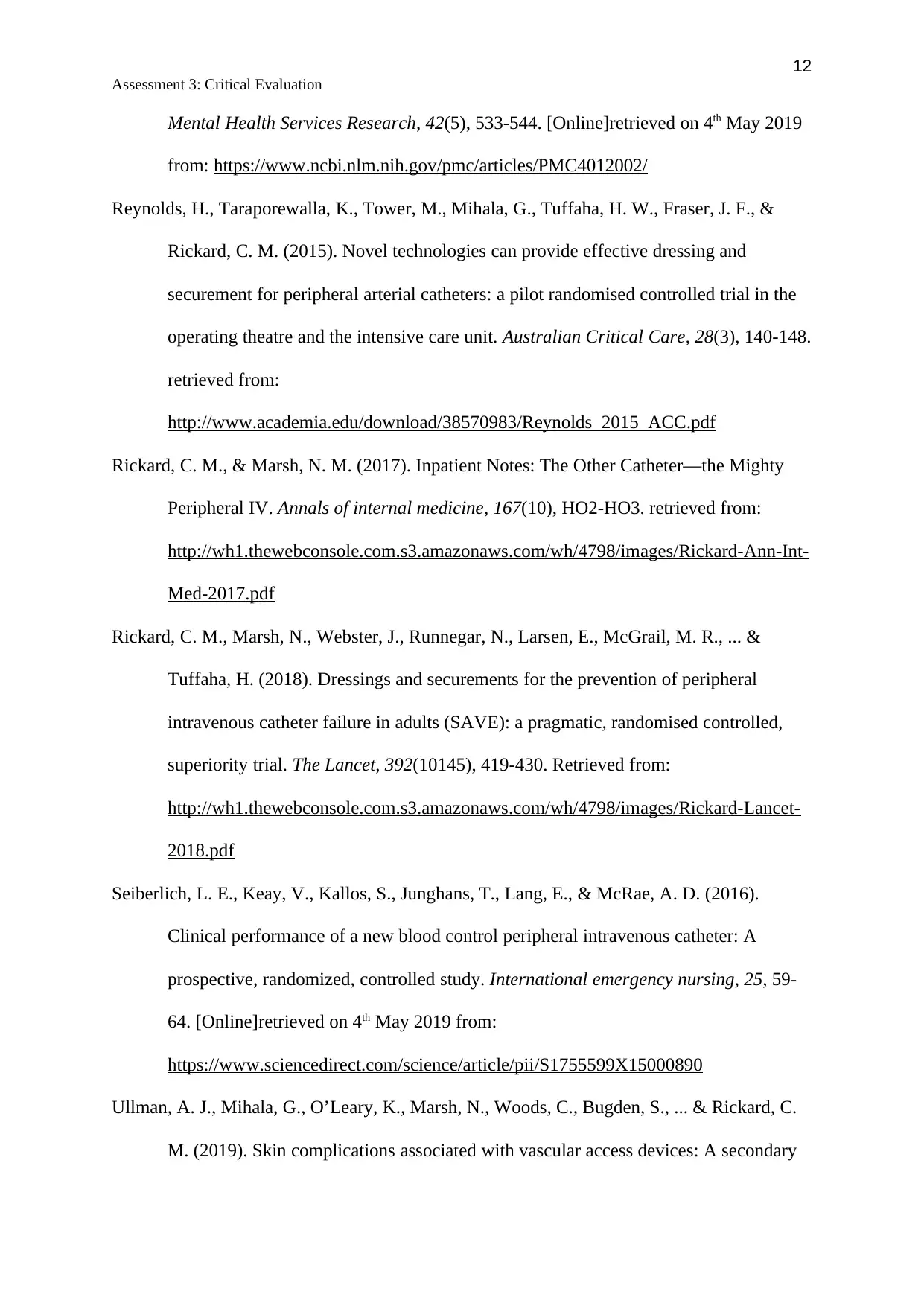
12
Assessment 3: Critical Evaluation
Mental Health Services Research, 42(5), 533-544. [Online]retrieved on 4th May 2019
from: https://www.ncbi.nlm.nih.gov/pmc/articles/PMC4012002/
Reynolds, H., Taraporewalla, K., Tower, M., Mihala, G., Tuffaha, H. W., Fraser, J. F., &
Rickard, C. M. (2015). Novel technologies can provide effective dressing and
securement for peripheral arterial catheters: a pilot randomised controlled trial in the
operating theatre and the intensive care unit. Australian Critical Care, 28(3), 140-148.
retrieved from:
http://www.academia.edu/download/38570983/Reynolds_2015_ACC.pdf
Rickard, C. M., & Marsh, N. M. (2017). Inpatient Notes: The Other Catheter—the Mighty
Peripheral IV. Annals of internal medicine, 167(10), HO2-HO3. retrieved from:
http://wh1.thewebconsole.com.s3.amazonaws.com/wh/4798/images/Rickard-Ann-Int-
Med-2017.pdf
Rickard, C. M., Marsh, N., Webster, J., Runnegar, N., Larsen, E., McGrail, M. R., ... &
Tuffaha, H. (2018). Dressings and securements for the prevention of peripheral
intravenous catheter failure in adults (SAVE): a pragmatic, randomised controlled,
superiority trial. The Lancet, 392(10145), 419-430. Retrieved from:
http://wh1.thewebconsole.com.s3.amazonaws.com/wh/4798/images/Rickard-Lancet-
2018.pdf
Seiberlich, L. E., Keay, V., Kallos, S., Junghans, T., Lang, E., & McRae, A. D. (2016).
Clinical performance of a new blood control peripheral intravenous catheter: A
prospective, randomized, controlled study. International emergency nursing, 25, 59-
64. [Online]retrieved on 4th May 2019 from:
https://www.sciencedirect.com/science/article/pii/S1755599X15000890
Ullman, A. J., Mihala, G., O’Leary, K., Marsh, N., Woods, C., Bugden, S., ... & Rickard, C.
M. (2019). Skin complications associated with vascular access devices: A secondary
Assessment 3: Critical Evaluation
Mental Health Services Research, 42(5), 533-544. [Online]retrieved on 4th May 2019
from: https://www.ncbi.nlm.nih.gov/pmc/articles/PMC4012002/
Reynolds, H., Taraporewalla, K., Tower, M., Mihala, G., Tuffaha, H. W., Fraser, J. F., &
Rickard, C. M. (2015). Novel technologies can provide effective dressing and
securement for peripheral arterial catheters: a pilot randomised controlled trial in the
operating theatre and the intensive care unit. Australian Critical Care, 28(3), 140-148.
retrieved from:
http://www.academia.edu/download/38570983/Reynolds_2015_ACC.pdf
Rickard, C. M., & Marsh, N. M. (2017). Inpatient Notes: The Other Catheter—the Mighty
Peripheral IV. Annals of internal medicine, 167(10), HO2-HO3. retrieved from:
http://wh1.thewebconsole.com.s3.amazonaws.com/wh/4798/images/Rickard-Ann-Int-
Med-2017.pdf
Rickard, C. M., Marsh, N., Webster, J., Runnegar, N., Larsen, E., McGrail, M. R., ... &
Tuffaha, H. (2018). Dressings and securements for the prevention of peripheral
intravenous catheter failure in adults (SAVE): a pragmatic, randomised controlled,
superiority trial. The Lancet, 392(10145), 419-430. Retrieved from:
http://wh1.thewebconsole.com.s3.amazonaws.com/wh/4798/images/Rickard-Lancet-
2018.pdf
Seiberlich, L. E., Keay, V., Kallos, S., Junghans, T., Lang, E., & McRae, A. D. (2016).
Clinical performance of a new blood control peripheral intravenous catheter: A
prospective, randomized, controlled study. International emergency nursing, 25, 59-
64. [Online]retrieved on 4th May 2019 from:
https://www.sciencedirect.com/science/article/pii/S1755599X15000890
Ullman, A. J., Mihala, G., O’Leary, K., Marsh, N., Woods, C., Bugden, S., ... & Rickard, C.
M. (2019). Skin complications associated with vascular access devices: A secondary
⊘ This is a preview!⊘
Do you want full access?
Subscribe today to unlock all pages.

Trusted by 1+ million students worldwide
1 out of 13
Related Documents
Your All-in-One AI-Powered Toolkit for Academic Success.
+13062052269
info@desklib.com
Available 24*7 on WhatsApp / Email
![[object Object]](/_next/static/media/star-bottom.7253800d.svg)
Unlock your academic potential
Copyright © 2020–2025 A2Z Services. All Rights Reserved. Developed and managed by ZUCOL.





